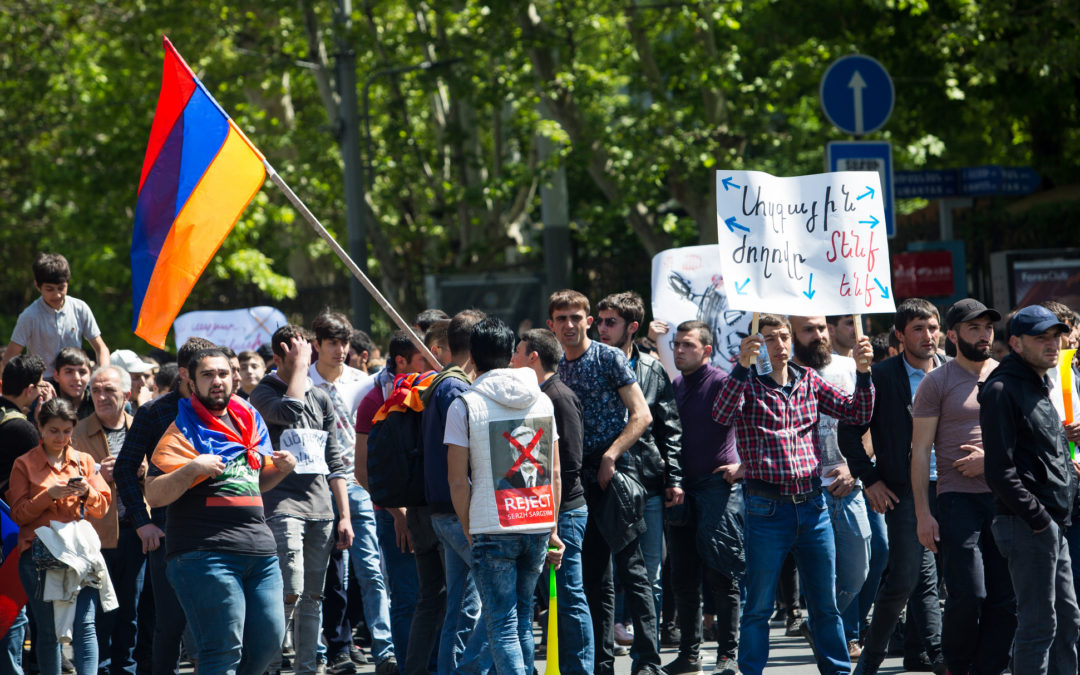Recent and ongoing unrest in Armenia, sparked by the recent appointment as prime minister of outgoing President Serzh Sarkisian, and his resignation a week later have been widely reported in domestic and international media.
Nearly two thirds of Armenians name unemployment, poverty, corruption, and lack of peace in the country as the most important issues facing this small land-locked country of some 3 million which became independent in 1991.
Web of relations, complex international issues
A war started in 1992 after the Armenian-majority territory of Nagorno-Karabakh declared independence from Azerbaijan in 1988. It ended with a ceasefire brokered by Russia in 1994. Armenia depends on Russia for its security.
Together with Belarus, Kazakhstan, Kyrgyzstan and Russia, Armenia is a member of the Eurasian Economic Union, which it joined in 2015.
Armenia signed also a Comprehensive and Enhanced Partnership Agreement (CEPA) with the European Union in November 2017.
Mixed media landscape
The constitution guarantees the right to freedom of speech and expression.
However, press freedoms are restricted. Armenia was ranked 80th in the 2018 Reporters Without Borders (RSF) World Press Freedom Index, and Freedom House, described Armenia as not free in its latest report
According to IREX, a non-profit organization, Armenia has over 36 active print outlets, 20 radio stations, and 17 TV stations (nine channels in Yerevan, capital, including two Russian state channels and CNN, seven stations with nationwide coverage, including one public station and MIR, the TV station of the Commonwealth of Independent States (CIS). There are also 22 TV stations in regions
The relatively large number of broadcast media outlets may give the misleading impression of a diverse media landscape. However, media ownership is opaque. Many media exist for the sole purpose of supporting a specific political party or figure.
News sources
Television is by far the most popular source for information about politics and current events. However, when asked (in 2017) “how well do you think TVs in Armenia inform the population about what is actually going on in Armenia?” 14% of respondents replied “very poorly” and 25% “quite poorly”, compared to 11% who replied “quite well” and 2% who said “very well”, with 44% replying average.
Radio is used by only about 1% of Armenians as a source of news.
Few Armenians rely on newspapers as their main news source. Print runs are small (1,000-6,000) and most titles are owned by wealthy individuals or political parties.
Internet access is on the rise. More than 2 million Armenians are online; around 72.5% of the population (2018); most users access the web via mobile devices.
The language barrier forces many Armenian journalists to use Russian-language sources over western-language alternatives, given the former an edge.
Television
Public TV Company of Armenia – H1, is the leading domestic channel. The state-owned national channel, not considered yet a full public service broadcaster, was launched in November 1956.
Others channels, all private, include H2, the country’s second channel, a general-oriented channel with the largest coverage of Armenia.
Armenia TV, launched in 1999 by the US-based Cafesjian and Sarkisian family foundations, with its American offshoot launched in 2007
Kentron TV, established in 2002 (available terrestrially and via satellite,
Radio
Public radio of Armenia is the state-owned radio broadcaster. Its website offers news in Armenian, Azeri, English and Russian. Its International Public Radio of Armenia website offers web-based text news in six languages: Arabic, Assyrian, Farsi, Greek, Turkish and Yazidi; services in eight other languages were discontinued in 2016.
Foreign broadcasts and web content for Armenia
Russian TV is widely viewed in Armenia, as Russian is understood by most people. Russian state channels are included in cable packages, a few channels are available terrestrially.
Some international broadcasters provide Armenian-language services.
Russia’s Sputnik, the umbrella company for the foreign-language websites and radio broadcasts of the Rossiya Segodnya (Russia Today) news agency has an Armenian website that offers news and access to audio content.
The US Broadcasting Board of Governors (BBG) has two networks that provide services in Armenian (in addition to services in Russian).
Radio Free Europe/Radio Liberty (RFE/RL) Armenian Service, Radio Azatutyuna, which produces content in Armenian and Russian, was established in 1953.
Every week it offers 20 hours and 40 minutes of radio content, and 100+ hours of TV.
Radio is distributed via FM, satellite, Internet, mobile devices, YouTube, social media, TV programmes are rebroadcast on some local channels.
Voice of America (VOA) Armenian Service, was established in June 1951. VOA describes it as “one of the agency’s smallest but most effective services, with a weekly reach of 32 percent in Armenia”.
The service’s programmes include
– A 10-minute TV report airing Monday through Friday.
– A 20-minute weekly TV magazine airing on Sundays and repeated on Mondays.
– The service produces also a daily five-minute segment for and Armenian TV show.
News from Armenian sources in English
A number of Armenia-based private and state news agencies and Internet news services offer news in English, and in some other languages
A1+, a news website – English-language pages
Arka a private news agency created in 1996 – English-language pages
Armenpress, state-run agency established in 1918 (reports in Arabic also) – English-language pages
Arminfo – a private news agency, created in 1991 – English-language pages
Mediamax, a private portal offering “news, analysis, exclusive interviews” – English-language pages
News.am – a private agency offering “timely and reliable news and information” (reports in Turkish also) – English-language pages
This wide range of media sources will ensure that ongoing political developments will be well covered and available in the country and abroad.
Research by AIB Media Analyst Morand Fachot.
